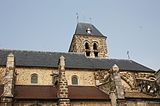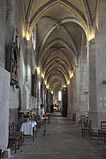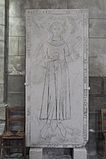St-Clément (Arpajon)
The Catholic parish church of Saint-Clément in Arpajon , a parish in the Essonne department in the French region of Île-de-France , was built from the end of the 11th or the beginning of the 12th century on the site of several previous buildings. In 1926, the church consecrated to Saint Clement of Rome was added to the list of architectural monuments in France as Monument historique .
history
In 1006, the then existing church in Arpajon was subordinated to the Benedictine abbey of Saint-Maur-des-Fossés , which set up a priory there and built a new church towards the end of the 11th or beginning of the 12th century according to an ambitious plan started. The choir and bell tower have been preserved from this construction phase . The construction work was probably not yet completed when the English King Edward III. set fire to the church during the Hundred Years War in 1360 . About 800 people who took refuge in the Church were killed. In 1510 the lords of the time , who came from the rich noble families of the Montaigu and Malet de Graville , had the church rebuilt. Their coats of arms are placed on the keystones of the nave . In the middle of the 19th century the west facade was renewed and the Romanesque portal was replaced by a neo-Gothic one. In addition, two chapels were added to the church.
architecture
Exterior construction
A Romanesque arched portal is walled up in the north wall , of which a slender column decorated with a capital has been preserved. The portal walled into the south wall dates from the Gothic period. It is covered by an arched archivolt and framed by columns with capitals. The tympanum is decorated with a clover leaf arch.
In the northern corner of the choir rises the 45 meter high bell tower, which is covered by a hipped roof and reinforced on all four sides by two buttresses . The upper floor is broken up by high, coupled sound arcades .
inner space
The church consists of a three-aisled nave , a choir with ambulatory and three chapels. The ribbed vaults of the two side apse chapels rest on consoles from the 12th century. The nave is divided into five yokes arranged and covered with a ribbed vault which on square pillars rests without capitals. The two-bay choir opens into an apse closed on three sides . Its ribbed vault rests on the capitals of the services that are in front of the mighty ambulatory columns. The capitals are decorated with acanthus leaves. During renovation work in the 1980s, the 12th century triforium between the arcade zone and the upper windows was discovered and exposed again.
Leaded glass window
The church is equipped with numerous leaded glass windows. Most of the windows were created in the 19th century in the workshop of Lucien-Léopold Lobin and his successor Joseph-Prosper Florence in Tours . Episodes from the life of Joan of Arc are shown on two windows . One window depicts Saint Korbinian , the patron saint of the Archdiocese of Munich and Freising and patron saint of the city of Freising in Bavaria , who was born in a neighboring town of Arpajon, in Saint-Germain-lès-Arpajon .
Furnishing
- The holy water font is in the 14./15. Dated century. It is provided with a coat of arms on one side, on which a Maltese cross and stylized lilies are depicted.
- The red marble baptismal font dates from the late 17th century.
Grave slabs
During the draining of the church in 1834 and 1995, several grave slabs were discovered that are now kept in the church.
- A relief of the deceased is engraved on the grave slab of the knight Pierre de Châtres († 1306). He is shown standing under an arcade with his hands folded. He is dressed in chain mail and a tunic , and a greyhound lies under his feet. In front of the sword, which is belted around his waist, you can see his coat of arms. Two angels are depicted above the arcade.
- The tombstone of the page by Pierre de Châtres is designed similar to that of his master. The deceased is depicted as a young man standing with folded hands under a clover leaf arcade. He too wears a long tunic and a sword, and a greyhound lies under his feet.
- Another grave slab shows Count Chase Conée, who died in 1314.
- A grave slab depicts a monk sitting on a chair under a keel arcade and holding a book in his right hand. The grave slab, the left half of which has not been preserved, is dated to the 14th century.
literature
- Jean-Marie Pérouse de Montclos (ed.): Le Guide du Patrimoine. Île-de-France . Hachette, Paris 2nd edition 1994, ISBN 2-01-016811-9 , pp. 112-113.
- Georges Poisson (ed.): Dictionnaire des Monuments d'Île-de-France . Éditions Hervas, Paris 2001, ISBN 2-84334-002-0 , p. 78.
- Le Patrimoine des Communes de l'Essonne. Flohic Éditions, Paris 2001, ISBN 2-84234-126-0 , pp. 37-40.
Web links
- Église Saint-Clément in the Base Mérimée of the French Ministry of Culture (French)
- Église Saint-Clément Diocèse d'Evry (accessed February 5, 2015, in French)
- Église Saint-Clément patrimoine-religieux (accessed February 5, 2015, in French)
- Église Saint-Clément topic-topos (accessed February 5, 2015, in French)
Individual evidence
- ↑ Holy water font in the Base Palissy of the French Ministry of Culture (French)
- ↑ Baptismal font in the Base Palissy of the French Ministry of Culture (French)
- ↑ Grave slab of the knight Pierre de Châtres († 1306) in the base Palissy of the French Ministry of Culture (French)
- ^ Grave slab of the page of Pierre de Châtres († 1317) in the base Palissy of the French Ministry of Culture (French)
- ↑ Grave slab of Count Chase Conée († 1314) in the Base Palissy of the French Ministry of Culture (French)
- ^ Tomb slab of a monk in Base Palissy of the French Ministry of Culture (French)
Coordinates: 48 ° 35 ′ 31.8 " N , 2 ° 14 ′ 52.2" E
















